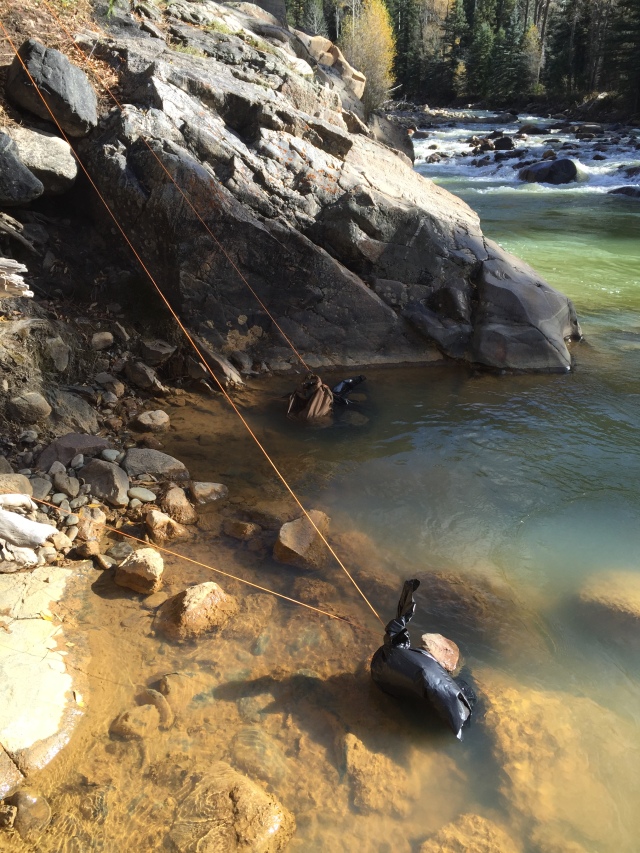Having hunted across the river last year, we daily saw the steam powered train passing through the canyon well below us and thought that using the train for backcountry access might indeed be a fun and adventurous way to access the backcounty of this region. Allow me to emphasize that using the train for elk hunting access in no way offers the hunter any access advantage. In fact, it may very well limit your opportunities since you cannot easily pull out and move areas if you don’t find what you are looking for. To add to the complexities, the train travels a very deep canyon at an elevation of around 8,000 feet and the elk in this country seen to often be found 10,500-12,000+, which is often a long and very complex climb from the canyon. Given the terrain considerations, hunting elk in this country can be more akin to sheep hunting in that you spot an animal one day and move on them the next. Many hunters do use the train for backcountry access, but most of these hunters are pursuing goats, generally in the popular Chicago Basin with once-in-a -lifetime tags that take years to draw. To add to these complexities, the train stops are in the heart of what has a solid reputation of being the most rugged hunting unit in all of CO as well as the area with the highest number of rescues in the state. Anyone scouring the internet ofor information on using the train for backountry hunting access should be advised that you should be willing to climb thousands of feet and push for miles before finding Elk in this country. A hunter stepping off the train to the East should be prepared to cross the Continental Divide (13,000+ feet). A hunter stepping off the train headed West, has far easier access options that will involve less vertical climbing.

After making the overnight 19 hour drive, we arrived in the town of Silverton around 7 am to fresh snow. Silverton is a small mountain town struggling to find modern identity. Until about 10 years ago, it was a mining town, but mining has since left the area and Silverton is trying to find its way as a tourist town. After eating breakfast, killing much of the day walking around town and watching the sun warm things up considerably, we went to the train station to check in only to discover that our train had broken down in route and that the first train was going back to pick up the stranded passengers. This is the way travel works. With the waiting game underway, our situation began to look increasingly bleak. There were a number of train passengers displaced by the broken down train and it became clear that only one train would be returning to Durango that afternoon. That particular train did not have any scheduled backcountry access stops, nor did it have a freight car for backpacks and gear. Buses were dispatched to pick up any disgruntled passengers and refunds were issued. Neither of those options helped our case much, so we sat tight talking to a pair of goat hunters in the same predicament. I will say that the train personnel were entirely professional, cheerful and pleasant to deal with during the delay. We were asked to wait until all passengers from the earlier train were boarded and, if there were room, they would let us board, even making an unscheduled stop to drop us off. After several hours of delay, we were granted access to board, wearing backpacks and carrying weapons. Once the train got underway, we were asked to move all of our gear to the very front of the train. Walking the length of the train with loaded packs and weapon cases was a very unnerving experience given how bumpy the ride was. I was genuinely afraid I was going to take a passenger out with my shifting heavy pack at any moment. Once we had a gear secured, we then walked the entire length of the train back to our open car and enjoyed the ride. Along the way, we passed the broken down train -they had helicoptered a mechanic in (how much does a fly in mechanic make?). I will say that riding the Durango train is an absolutely exhilarating experience unto itself. If you ever find yourself in Southwest CO, I can’t emphasize enough how unique and amazing this train ride is. The landscape is stunning and intimidating once it sets in what you will be climbing to get out of the canyon.
After again walking the length of the train in preparation for unloading, we were dropped off promptly, with the stop taking only as long as it took for us to unload our gear, less than 2 minutes, and then the train was gone just like that. Since we were running so late in the day, it was very close to being dark. We wished the goat hunters well and they headed out hoping to at least cover an uphill mile before dark. Despite having been up for 40+ hours, we were feeling energized after the train ride. We quickly cached some extra gear and our rifle cases and headed in about half a mile to set up a camp that we would use as a homebase to scout from for the next couple of days. For acclimation purposes, we decided it best to sleep in the following day and get started on some scouting. We ended up getting going around 9 am the next morning and hiked a couple of miles up the canyon and then began a hard ascent up a very steep drainage. We estimated 3 hours of climbing, but for some reason, decided to take an alternate sub drainage which turned out to be quite technical and challenging and, in the end, offered no shortcut to the top. In fact, we found ourselves entirely cliffed out to the summit with only 2 ways back down: reversing the drainage we ascended or descending the sister drainage on the other side, which looked just as technical. Surprisingly, there was a tremendous amount of mule deer sign and even some old elk sign on this isolated outcropping. I have no idea how elk and mule deer are able to negotiate 5th class obstacles in goat country, but they do. Despite our entry and exit options, we had an commanding view of the surrounding country and were able to put some time in glassing before a storm moved in rather suddenly.


With a storm on us and a unknown decent, we decided it best to descend while we still had daylight. Good thing. The descent turned out to be a very steep and loose gully with many technical obstacles. The rock was so bad that we had to descend sections one at a time to avoid hitting each other with loose rock. RM took a pretty good fall at one point that I thought was going to turn out really band, but he managed to right himself and used the friction of his pack to slow himself down. A few cuts, bruises and torn clothes later, we were on our way. As is the case throughout the San Juans, the terrain just seems to keep going and get perpetually more complicated the further you go. Every time we thought we were clear of the gully, it would throw another obstacle at us. A few more scrapes, bruises, torn clothes and a bent trekking pole later, we were spit out of the gully on a steep rock face that took us until well after dark to get down. Hard day. Not very productive either.

The next morning, I awoke early with the plan of climbing to 10,000 feet to check out a drainage that we did not have a good vantage point for the previous day. Unfortunately, RM was already up and had been up all night passing kidney stones. ouch! There’s not much of anything I could do to help, so I guzzled a cup of coffee and some breakfast and headed out to start climbing in the dark and it was it STEEP! That uphill climb hit me like freight train. My plan for the the morning was to stay off the rock faces but I quickly grew tired of kicking foot holds in the steep dirt, so I eventually moved out on a rock face and made pretty decent time. I spent the entire day glassing in the hot sun. I checked in with RM via radio at 2 PM and he was still passing stones. I had hoped to stay put until dark, but I wasn’t sure about the descent. I had done some moving around over the course of the day and knew I had some ledges that needed to be avoided, plus there was a particulalry steep rock face. I started to descend, thinking I might stop once past the technical parts, but, it took me so long to pick my way through the rocks that it was dark before I was halfway down. Despite my efforts, I hadn’t really seen much to get excited about within a 3 mile radius. Our plan was to spend the next day relocating ourselves for opening day. Since I had not been able to glass anything, we were relying more on what we expected the elk might do to escape the heat, which was use the North face of a long, shady drainage, however, I happened to run into the two goat hunters the next morning when I went to pick up food for the next 5 days from our cache. They had successfully arrowed a goat at 13,500 feet and, as result, had surveyed the entire area. They told us about a herd of elk in a remote drainage about 8 miles away. It can take some faith in humanity to heed such advice from strangers, but these guys seemed solid and we had no real hard evidence any any recent elk in the immediate area. We wished each other well and started our ascent. Miraculously, most of the distance was relatively moderate and tame by San Juan standards and we were able to get within 1.5 mile of our destination by mid afternoon.


There is little, if any flat ground in the San Juans. Sleeping in a hammock is definitely the way to go here, but I am a stomach sleeper and just can’t get comfortable in a hammock, so I usually just find the flattest ground I can and deal with being down hill in some direction. The usual camp set up joke is “San Juans: Where even the flat spots are steep”, however, we came across an abandoned mining camp where someone had painstakingly removed rock from soil, flattened out the ground and built retaining walls with the displaced rock. This must have been absolute backbreaking labor. A flat piece of ground in the San Juans? Who can pass that up? We quickly made camp and set out for our destination thinking we could scout during the late afternoon. Our pace and moderate terrain instantly gave way to VERY steep and difficult climbing with blowdown and technical rock out croppings. 2 hours later, we had covered a mere .4 miles (point Four -less than a half a mile), about a 3rd of the way there with no sign of the terrain letting up. Well, this was going to be tough. We returned to camp to get as much sleep as possible in anticipation of a long day.

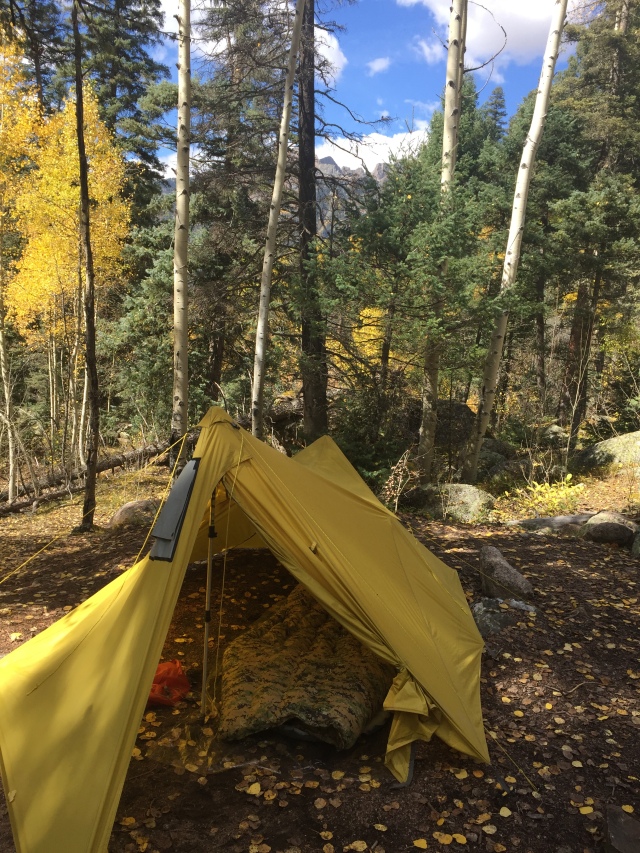
We awoke very early the next morning and began the long, arduous journey. It was incredibly slow progress at times. About halfway there, we began a long traverse, but there were steep gullys that either required we climb higher or drop down lower and then regain altitude. In the dark, trying to determine the best investment of our energy was just a guess. As a result, we ended up descending several hundred feet only to have to re-climb to the same elevation. This happened multiple times. There was also lots of thick bushwhacking, blowdown and technical rock faces to negotiate. 4.5 hours later, we arrived to our destination. It was already light and the thermals were beginning to rise, so we did some more climbing to escape the noses of any elk. Once we were above the drainage, we could smell elk in the rising thermals. Good sign. Within minutes of glassing, I began to spot some elk, including a bull, that were about a mile away. Since the smell of elk was so strong, we knew there must be animals closer and did not want to risk pushing them out, so we kept a conservative approach to our hunting until the afternoon heat set in. Hot even at 12,000+ feet in October! Temperatures were running 20-25 degrees above average for the region.

Our original plan was to sit until late in the afternoon and then see what stepped out into the shade, however, it was so hot that we became concerned we would see no daylight movement, so come mid afternoon, we began calling and we sure got things in that drainage stirred up. We received two responses almost immediately followed by a third response that suggested one bull was on the move towards us. We quickly shuffled our setup around a bit with me watching our back in case the bull tried to circle around downwind. That scenario seemed fairly unlikely given the terrain and the fact that he would have to walk a good ways in the direct sunlight since we were right at the treeline. The bull bugled again, this time very close. We were both looking for him through our optics, but could not see him. RM pulled his optics down to discover the bull standing 30 yards away looking right at us and he quickly took the shot without hesitation. Since we had multiple bulls bugling, I immediately jumped in the hot seat and RM began calling super aggressively. At this point, all of the bulls in the drainage seemed to be really beside themselves and worked up. There were several bugling and lots of movement along the treeline. A spike steps out and timidly comes into investigate. He came inside of 15-20 yards, but this unit has antler restrictions, so we just enjoyed watching him at such close range. During this time, I saw what I thought were a pack of goats way up high. A quick look through the optics revealed them to actually be elk and there was an entire string of them moving along what could at best be considered a goat trail. These elk were moving through terrain that I would never imagine elk would use. As some time went by, there appeared to be a mass exodus of elk using this same goat trail out of the drainage. At the base of this path was a bull bugling like crazy and I couldn’t take it anymore, so I went charging down the mountain and up the other side directly to him, bypassing the spike in the process. By the time I got there, I was completely out of breathe and in no condition to take a shot, but he seemed to be holed up in some thick cover anyway. In the rush to get there, I had forgotten my call, so I began beating a tree with a stick and making a bit of a ruckus trying to lure him out, though that tactic seemed to have the opposite effect.

Care to take a guess of the age of this Mule Deer?
At this point, dusk wasn’t that far away and the reality of our pack out situation was beginning to set in. “What am I thinking? There’s no way we can pack two elk out of here!” I made my way back over to RM and was absolutely parched by the effort to get there. Elk were still pouring out of the drainage and 2 bulls were constantly bugling. We take some pics and began setting up for the butchering job when we noticed some movement below us. I quickly grabbed my rifle and set up for a 186 yard shot with a large group of cows emerging below us. They were herded up pretty tight so I did not have a clear shot. At this point, I mention to RM that we probably should not be taking another animal because of the pack out. No sooner were these words out of mouth when a huge bull steps out behind the cows. I think we both laughed out loud. I put my crosshairs on him and kept them there for a few moments while debating our situation and trying to justify a shot. Just as he stepped back into the treeline, he paused with his vitals exposed. I felt my finger begin to apply pressure, knowing that I was going to regret this decision, I quickly released any trigger pressure and moved my line of sight away from the rifle optic. “I may regret this one day, but not today.” I promptly unloaded my rifle as not to be further tempted and we began to butchering process. The bull I passed on was a BIG bull….. of course it was a big bull. That’s how hunting stories go.

Personally, I enjoy the process of butchering, but an elk on the ground is a serious undertaking, even for two people. We used the gutless method and took as much meat as we could get including rib meat, brisket and other trimmings that many people leave for the scavengers. Once finished, we packed the meat 200 yards downhill in two loads where we hung it in the trees over a creek. Up to this point, we were intending to take a light load of meat and the rifles back with us that night, coming back for two more loads over the next two days, though, it was Midnight, we were out of food and had been for hours, were both completely exhausted and were facing the much dreaded dreaded 4.5 hour trip back out that was both complex and technical. We made the decision not only to leave all of the meat, but to leave our rifles behind as well. This decision later revealed itself to have been critical.
I have a bit of history (which means there are a couple of good stories) with regards to mountain descents gone wrong. Calorie deprived, dog tired, and making decisions at midnight about the best way back to camp after you’ve been up for well over 20 hours are not necessarily the best circumstances to take a gamble on an unknown route down the mountain. “We should just follow the river out”. Famous last words….. To be fair, the river was flat and tame enough where we were at its origins and the river was reasonably flat and tame enough near our camp, though there was a short, but intense waterfall. Any reason to anticipate that we would later find ourselves overcommitted in an inescapable gorge, rock hopping down the middle of a raging river and desperately clinging to a hand traverse while feet scraped away at slick wet granite on the edge of a 80 foot waterfall clogged with avalanche debris at 3 AM? Well, that’s where we found ourselves. We made irreversible moves on at least three different occasions, crossed the river well over a dozen times. Had we packed meat out, or even had our rifles to deal with, the outcome may well have been very different. This was technical canyoneering at its finest and we could only see the length of our headlamps. I really wasn’t entirely sure we would make it out of that river gorge that night, definitely did not think we would make it out with little more than wet feet, but somehow we persevered and arrived back in camp a little after 4 AM. Descents such as this one are the very reason you carefully choose your hunting partners for mountain trips. Certain types of people tend come unglued in such circumstances, but what can you do other than deal with situation you find yourself in? We did just that. Despite the urge to collapse, we took the time to eat a full meal as we were severely calorie deprived and were going to need the recovery and energy for the next day.

I awoke slowly to a crisp and sunny October Sunday. My first first mental reference was waking up with an intense Sunday morning hangover back in college. It felt late. The sun was high. I pulled myself out of the tent in a mental fog. I sat still, maybe it was the mental reference to a bad hangover where you just pretend that you aren’t going to vomit. Lucky for me, I have much experience in this department. I moved very little until I was on my second cup of coffee. Then I checked the time and it was well after 1 PM. RM woke up about then and was shocked by the time of day. Even if we left for the first load of meat now, we would be coming back well after dark. Plus, we were going to need to shove down at least 1,000 calories and get hydrated first. After last night’s ordeal, we quickly arrived at the conclusion that the meat would be fine where it was, we had a sufficient amount of days to pack it out and that we needed a rest day in order to spend the next couple of days packing heavy loads. We spent the rest of the day not moving more than 30 yards from camp. We were only up for about 7 hours, probably the shortest day of my adult life, but we made the most of it by eating as much as we could, rinsing off in the river and mentally preparing ourselves for the task at hand. We were back in bed and sound asleep before sunset that evening.

The next 2 days was a blur of monotonous work. 12 hours days of hiking in, loading up, eating, packing back out, eating and getting to sleep as quick as possible. We worked to perfect our approach and return by marking GPS tracks of where to ascend, where to traverse and stay high, where to drop low and what to avoid. We eventually got the approach pretty wired down and were able to shave 30 minutes off our time. Under the weight of meat, the return was very difficult. There was no place to even take our heavy packs off until we were .29 miles from camp unless we wanted to risk shouldering a 70 pound pack while standing on unstable rock at a severe angle. We both took some falls, nothing too serious, but lots of bumps, bruises, cuts and more torn clothes. I took a pretty good spill while holding on to a sapling that uprooted, sending me down a ravine. RM took a pretty good one when a large rock shifted. He managed to cut himself up pretty good. The toughest part of the return was the hours of constant mental focus: where to place your feet, trusting your life to your trekking pole or a small foothold. The technical climbs were extremely stressful with our heavy packs + rifles and footing was a constant problem -sliding dirt, loose rock, shifting rock faces, blowdown etc. I wasn’t able to take many pics of the pack out simply because it was “all hands on deck” the entire time for 12 hours a day, every day for three days. The trip was so technical that we had to split the skull since we could not pack out the antlers out as one piece without getting snagged every few steps.

With the meat staged back at camp, our plan was to pack a heavy load of meat back to the railroad tracks and then pack out the next day with camp and the remaining meat. However, we awoke to discover that a bear had found our meat cache, had managed to rip a game bag open and got away with at least a mouthful. The stolen meat itself didn’t bother us so much as the concern that the bear would return. We quickly arrived at the conclusion that we should pack the entire elk out in one load, so we spent quite a bit of time figuring how to load our packs with two large and 1 small game bag each. With pack weights well North of 100 pounds each, we helped each other to our feet, buckled down tight and made the 6 mile hike out (moderate terrain and even a trail on part of it) under crushing weight. The first 4 miles wasn’t too bad, but the last 2 started to get increasingly miserable. Once back down at ~8000 feet, it was HOT, so we placed the meat in bags and submerged them in the cold river. Good thing we had whiskey cached! We ate some food and made the return hike back up with only water on our backs, which was quite the feeling of liberation.

Back at camp, we kicked off our boots, soaked our feet in the freezing cold water and took turns sipping bourbon. I had cached a sample bottle of Red Stag. It wasn’t very good, but I thought the description was appropriate for our situation even if Jim Beam’s marketing team failed to realize that Elk and Stag are not the same animal. RM came better prepared with a flask of Blanton’s. We triumphantly ate our last backcounty dinner and packed out early the next morning. At the train stop, we ran into another goat hunter who we talked with a great deal while waiting on the train. We heard the train rumbling down the track and flagged it down for a stop (is that a Johnny Horton song?). To our surprise, there was a large crew of elk hunters getting off the train and, wow, did they have a lot of cargo to unload. Multiple Yeti coolers, wall tent, toilet, tree stand (??), two folding tables, cases of soda, piles of junk…. it was shocking. One of them mentioned that they had been coming out there for 10 years. It looked to me like they were prepared to be there for 10 years. Basecamp hunting in this area would not seem to be the way to go. Unless it was an unusually heavy snow year, one would seemingly spend hours climbing each day. 4-5 hours minimum each way. That’s going to leave little time for sleep. I suppose you could have an outfitter bring stock in, but there are very few trails and what trails there are tend to be very popular hiking trails so even then you would spend quite a bit of time climbing because the terrain is, for the most part, too rocky and rough for horses. I’d also think that having the amenities of basecamp would make it difficult to spike out. Presumably these guys had coolers full of steaks and beer. Really, how strong is your motivation to spike out, climb thousands of feet and eat dehydrated meals when you have the comfort of a toilet seat back at basecamp? And a treestand? The terrain is so steep, I can’t imagine any advantage a tree stand would offer? Want to be 25 feet above a wallow, climb 10 feet up the hill. Not to mention hauling that piece of metal around the mountains. Once back on the train, we quickly obtained fresh cups of non-instant coffee, enjoyed the ride with our new friend Michael the goat hunter and politely answered the inevitable questions from curious tourists.

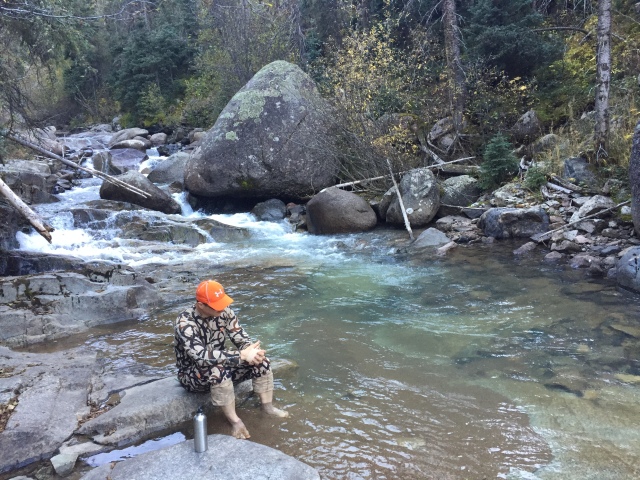
The physicality of a hunt like this in such rugged country can not be emphasized enough. The San Juans will flat out kick your ass no matter how good of shape you are in. By the third day, my legs and hips were pretty sore and they stayed that way the entirety of the trip. I lost 12 pounds while eating 4,000 calories a day. I have nicks, cuts, and bruises all over my body. My clothes are torn, ripped and even shredded in places. Boots have entire chunks of leather torn out of them. Our hands are so shredded from catching falls that we discussed wearing kevlar or tactical gloves with some plastic armor in the future. The San Juans are a good test of ruggedness for anyone looking for a challenge, but it is definitely not for everyone.
 When my friend and hunting partner, TC, managed to draw a much coveted Coues deer rifle tag in a trophy unit of Arizona, I jumped at the opportunity to come along as an extra set of eyes and intuition. Though the better hunting is usually had towards the end of this particular rifle segment, holidays, family commitments and logistics limited us to a window of time between Dec 11 and 20th. We entered this vast and rugged country with untrained eyes and no real relative sense of what we were searching for other than an allusive Whitetail, masterful in the art of ghosting. Through sustained days of hunting, we did manage to become rather adapted to spotting these animals, figured out some of their tendencies and even found success.
When my friend and hunting partner, TC, managed to draw a much coveted Coues deer rifle tag in a trophy unit of Arizona, I jumped at the opportunity to come along as an extra set of eyes and intuition. Though the better hunting is usually had towards the end of this particular rifle segment, holidays, family commitments and logistics limited us to a window of time between Dec 11 and 20th. We entered this vast and rugged country with untrained eyes and no real relative sense of what we were searching for other than an allusive Whitetail, masterful in the art of ghosting. Through sustained days of hunting, we did manage to become rather adapted to spotting these animals, figured out some of their tendencies and even found success.

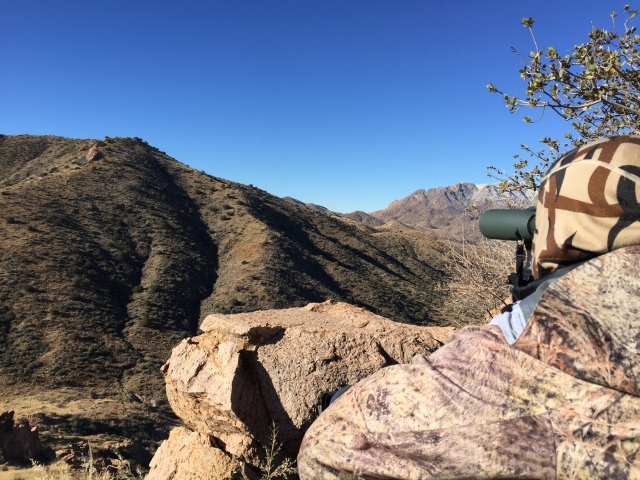








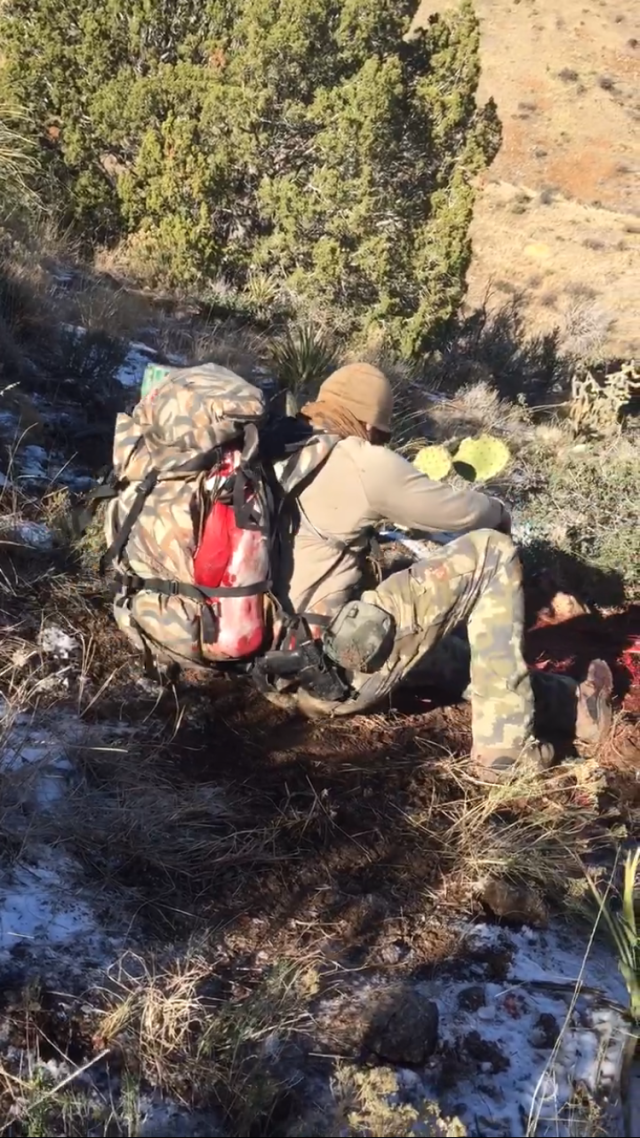

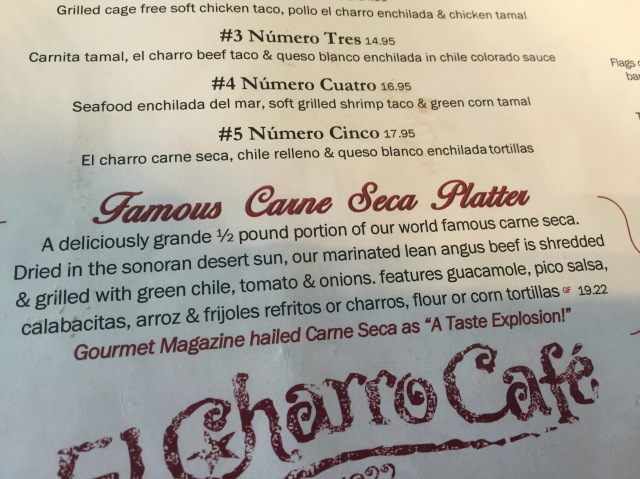

 I’m not easily impressed with Thanksgiving turkeys. In fact, I’m fine with skipping traditional turkeys altogether in favor of venison, duck or goose, which are more traditional in terms of Thanksgiving table fare. For round 1 of Thanksgiving (hosting a work related party), we kept things pretty straight forward and offered turkey and ham. (our personal Thanksgiving meal will be centered around a elk roast). After years of experimenting with Thanksgiving birds, I believe we have cracked the code.
I’m not easily impressed with Thanksgiving turkeys. In fact, I’m fine with skipping traditional turkeys altogether in favor of venison, duck or goose, which are more traditional in terms of Thanksgiving table fare. For round 1 of Thanksgiving (hosting a work related party), we kept things pretty straight forward and offered turkey and ham. (our personal Thanksgiving meal will be centered around a elk roast). After years of experimenting with Thanksgiving birds, I believe we have cracked the code.  The TVA did very little in the way of logging or habitat management and, with the exception of some agricultural leases, the land remained unaltered in a state of mature hardwoods for a number of years. As aesthetic as this may seem, mature hardwoods just don’t provide great habitat for Whitetails. Once the NPS took over, they began doing a bit of rotational select logging, developed wildlife habitat programs and they also developed a Elk and Bison range on the KY side. As far as deer hunting, LBL remains open to archery hunting for the duration of the statewide season, but firearm hunting is only permitted on two quota hunts which operate on a priority point system. Most hunters get drawn about every 3 years or so. I was fortunate to draw my first LBL tag with only a single priority point.
The TVA did very little in the way of logging or habitat management and, with the exception of some agricultural leases, the land remained unaltered in a state of mature hardwoods for a number of years. As aesthetic as this may seem, mature hardwoods just don’t provide great habitat for Whitetails. Once the NPS took over, they began doing a bit of rotational select logging, developed wildlife habitat programs and they also developed a Elk and Bison range on the KY side. As far as deer hunting, LBL remains open to archery hunting for the duration of the statewide season, but firearm hunting is only permitted on two quota hunts which operate on a priority point system. Most hunters get drawn about every 3 years or so. I was fortunate to draw my first LBL tag with only a single priority point. With no time to scout the area and with the consideration that hundreds of hunters would suddenly be hitting the woods, my general tactic for hunting LBL was to get into a remote area and stay put over a key terrain funnel for the duration of the hunt. With a general shortage of available cover, so many hunters suddenly entering the woods, and the fact that rutting activity is brewing around the time of this particular hunt, you can generally count on deer to be the move, either rutting or being bumped by hunters throughout the day. On these quota hunts, you are issued one deer tag, good for either sex, however, with a freezer full of elk meat, regular access to good local hunting land and LBL having a general reputation for being the “Land of Giants” (with regards to Whitetails), my plan was to remain highly discriminant if and when the opportunity to pull the trigger presented itself.
With no time to scout the area and with the consideration that hundreds of hunters would suddenly be hitting the woods, my general tactic for hunting LBL was to get into a remote area and stay put over a key terrain funnel for the duration of the hunt. With a general shortage of available cover, so many hunters suddenly entering the woods, and the fact that rutting activity is brewing around the time of this particular hunt, you can generally count on deer to be the move, either rutting or being bumped by hunters throughout the day. On these quota hunts, you are issued one deer tag, good for either sex, however, with a freezer full of elk meat, regular access to good local hunting land and LBL having a general reputation for being the “Land of Giants” (with regards to Whitetails), my plan was to remain highly discriminant if and when the opportunity to pull the trigger presented itself. I arrived well behind schedule on the day before the hunt with only 3 hours of daylight left. Using a topo map, I had pre-scouted an area with good terrain funnels and headed in with camp on my back. Very few, if any hunters, actually camp in the woods, though I did see several car campers. Most opt for amenity camping or stay at the local hotel which advertises a walk in deer cooler as a selling point. Day 1 went pretty well with some deer sightings, all of them well within shooting range. I saw 4 different does and 2 bucks, all between the hours of 10 am and 2:30 pm. With the exception of one of the bucks who seemed intent on seeking out estrous does, the other deer all appeared to have been bumped by hunters leaving and entering the woods. Since I was hunting a mere few hundred feet from camp and with the short days, I was able to log somewhere in the neighborhood of 10-11 hours of sleep each night, which was great. I did jump online after the first day to check the harvest reports and saw that 99 bucks had been checked in, including several 12 pointers, a couple of 13 pointers and even a 14 pointer. There were also several Whitetails checked in that weighed in the 225-250 pound range, which is about as large as Whitetails get in this part of the country.
I arrived well behind schedule on the day before the hunt with only 3 hours of daylight left. Using a topo map, I had pre-scouted an area with good terrain funnels and headed in with camp on my back. Very few, if any hunters, actually camp in the woods, though I did see several car campers. Most opt for amenity camping or stay at the local hotel which advertises a walk in deer cooler as a selling point. Day 1 went pretty well with some deer sightings, all of them well within shooting range. I saw 4 different does and 2 bucks, all between the hours of 10 am and 2:30 pm. With the exception of one of the bucks who seemed intent on seeking out estrous does, the other deer all appeared to have been bumped by hunters leaving and entering the woods. Since I was hunting a mere few hundred feet from camp and with the short days, I was able to log somewhere in the neighborhood of 10-11 hours of sleep each night, which was great. I did jump online after the first day to check the harvest reports and saw that 99 bucks had been checked in, including several 12 pointers, a couple of 13 pointers and even a 14 pointer. There were also several Whitetails checked in that weighed in the 225-250 pound range, which is about as large as Whitetails get in this part of the country.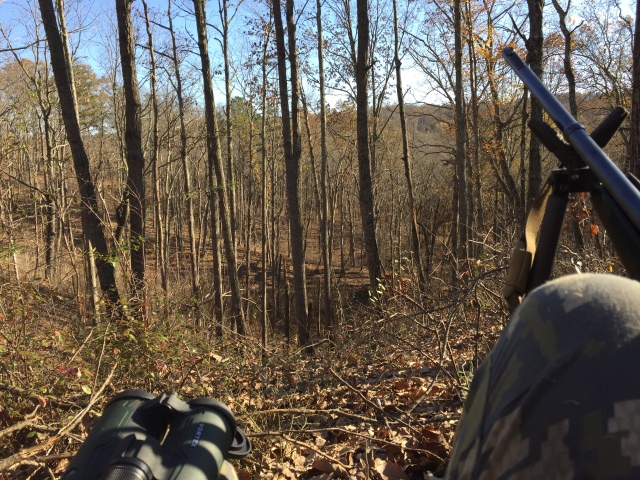 As quota hunts tend to go, day 2 was significantly slower in terms of shots heard and deer sightings. By this point, many deer tend to figure out some safe areas, be it safety zones off limits to hunting, or overlooked pockets of hunting pressure. Despite another all day sit, I did not see a single deer on day 2. I spent a third night in the woods before heading out and back home. Though, LBL was a bust for me, the area and the nature of the quota hunts has the potential to produce big buck sightings for almost any hunter sitting anywhere at any time. As a result, I’ll look to rebuild a priority point or 2 with the intentions of returning in 2017 or 2018.
As quota hunts tend to go, day 2 was significantly slower in terms of shots heard and deer sightings. By this point, many deer tend to figure out some safe areas, be it safety zones off limits to hunting, or overlooked pockets of hunting pressure. Despite another all day sit, I did not see a single deer on day 2. I spent a third night in the woods before heading out and back home. Though, LBL was a bust for me, the area and the nature of the quota hunts has the potential to produce big buck sightings for almost any hunter sitting anywhere at any time. As a result, I’ll look to rebuild a priority point or 2 with the intentions of returning in 2017 or 2018.
















